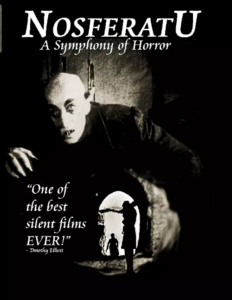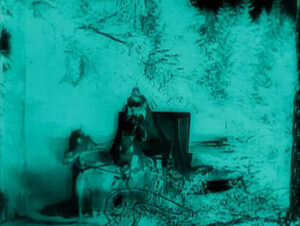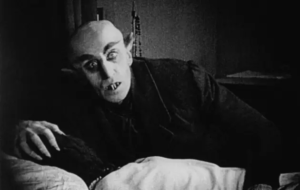„Nosferatu” – The Story of the Erotic Nature of Evil

Title: “Nosferatu. A Symphony of Horror”
Release Date: 1922
Director: Friedrich Wilhelm Murnau
Cast: Max Schreck, Alexander Granach, Gustav von Wangenheim, Greta Schröder, Georg H. Schnell, John Gottowt, Gustav Botz, Max Nemetz, Wolfgang Heinz
„Nosferatu. A Symphony of Horror” by Friedrich Murnau, a black-and-white silent film, created the basics of horror. This is a story about the evil located in unlimited eroticism, seducing the people to destroy the civilization and the culture.
Murnau directed „Nosferatu” in 1922 as an adaptation of “Dracula”, the Bram Stocker’s novel. Incidentally he infringed on the copyright of the book, leading to show-movies ban and even attempts on destroying the film’s copies. Fortunately „Nosferatu” survived to present times so everybody can watch the masterpiece.
The film tells the story of hiding as Count Orlok vampire, inhabiting the castle in Transylvania. One day he is visited by Hutter, young real estate agent, who wants to sell him the house in the small German town. Nosferatu, very pleased with this offer, decides to go to Europe and in the process causing spreading the mysterious disease everywhere he goes. Meanwhile, Hutter, having discovered the real identity of Orlok, tries to warn and save his wife from the disaster. Unfortunately Ellen, lured with Nosferatu’s magic, gives herself to him. The woman’s act rescues the town and completely ruins the monster.

“Nosferatu” – the evil comes from outside
The vampire in the Murnau’s film is a symbol of the evil destroying the culture and the civilization. Significantly, Nosferatu arrives in Europe from the outside – from wild The Carpathians, meaning that the source of destruction is located on the outskirts. That issue looks different in subsequent horror movie, where the evil sticks around in the very centre of the civilization. Moreover, Nosferatu belongs to the uncontrollable order of nature. Murnau designs in full swing the picture of landscapes – space of mountain ranges, Black Sea, Romania and Slovakia.
As a result Murnau makes a contrast between the array of wildlife and the structured city – the symbol of European culture. Then he tends to take the view that evil comes from violation of mysterious and unknown nature’s laws. In the film the wildlife has an eruption of repulsive and detrimental forms, like carrying the diseased rats and spiders or carnivorous plants. The animal sphere refers to the dark site of human being, to what is irrational and out-of-control of the sanity.
“Nosferatu. A Symphony of Horror” – sexual charm of the monster
„Nosferatu” shows the erotic nature of the monster. Regarding this matter the most important is how the vampire seduces his victims, that is to say, he hypnotizes the people and then drinks their blood. The blood is a very erotic symbol, referring to the family ties, the inheritance of the same genes from generation to generation happens during this sexual act. Drinking the human blood by the vampire represents the perversion, uncontrolled by social norms. The most significant are the last scenes Nosferatu flirting with innocent Ellen. Only later the camera shows the dreadful shadow of the coming vampire, there are a black contour of a hand and the claws on the white nightgown.

One of the final scenes presents Nosferatu kneeling at the Ellen’s bed and virtually blurring with the woman into one. According to an old wise book, should the heroine keep the creature in her bedroom to the morning, he will be vanquished. She has succeeded but simultaneously she also dies. The monster, understood as the liberty of being different, as well as in erotic terms, is definitely destroyed and removed itself from the civilization.
“Nosferatu” – expressionism and use of symbols in horrors
“Nosferatu” is a movie set in poetics of German expressionism. Interestingly, unlike almost all the rest of works representative for this stylistics, the main space of the film is not the distorted interiors but the locations. The nature is stylized in a way to collaborate with the mood of luridness. Secretiveness of the climate is built by the masterful light play, especially in the nocturnal scenes. Murnau uses chiaroscuro, the illumination of the darkness with metaphysical glow and, what is distinctive for Rembrandt’s paintings, catching from the dim space only the particular, meaningful objects. Among these esoteric props there are such things like the clock with the creepy human skeleton, ticking the midnight, the secret ledger about ghosts and vampires, the candles or the coffins.
Furthermore, the very significant object in “Nosferatu” is a mirror, the symbol of the troubles with the characters’ identity. Hutter is for instance the hero flexing in the looking-glass, studying the alleged bites of mosquitos, in fact the marks of the vampire’s teeth. The mirror is also an important element of decor of the Hutters’ matrimonial bedroom. Right before the advent of Nosferatu, it reflects the figure of Ellen. We can say that looking into the glass means the attempt of getting to know one’s self-subconscious and discovery the hidden truth about themselves.

In addition, what plays very important role in “Nosferatu” are symbolic space of interiors: the castle inhabited by the vampire, psychiatric hospital, staying possessed by a demon Knock, and the lower deck of the ship the monster travelling to Europe. That area is closed, labyrinthine and multi-level, maintaining the heroes’ involvement in the evil and the threat of loose their minds. Murnau creates a terrified climate and metaphysical aura of space-time thanks to using the negative tape, effecting with the white figures on the black backdrop. Not only this trick is followed by the director, but also he takes advantage of “film toning”, the process of colorization the chosen parts in one hue.
In conclusion, Friedrich Wilhelm Murnau, building the expressionistic climate of the movie, creates Nosferatu, becoming a kind of model for every subsequent imaginations of vampires in the cinema. Creepy, tall, bug-eyed creature, with unnatural long arms, claws, pointy ears and big fangs – definitely de-humanized figure, is the picture of “Alien” – the irrational power, unacceptable in our culture. This old silent movie offers a wealth of thought-provoking watching and still is as gripping as it was one hundred years before.
